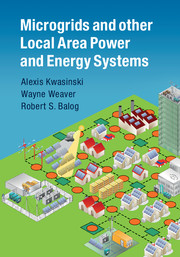3 - Techno-economic analysis
from Part I - Motivation
Published online by Cambridge University Press: 05 July 2016
Summary
Introduction
This chapter discusses key concepts and evaluation metrics used to describe and quantify the value proposition of a local area power and energy system (LAPES). Often the engineer is asked to evaluate multiple options and create a justification for a recommendation. Concepts of techno-economic analysis explored in this chapter are useful to compare the LAPES to a traditional system as well as to explore the cost-benefit tradeoff of various LAPES designs, configurations, and operating modes. Higher power quality, energy availability, and reliability of small-scale and distributed power systems are often touted as significant advantages over a conventional utility electrical system. While LAPES may indeed offer technological advantages, in order for it to be a practical engineering solution a comprehensive economic valuation of these benefits must occur in order to build the business case for a LAPES system. That is, higher availability and reliability may come at a cost that is unaffordable for a given application. Thus, this chapter explores tools and techniques to perform a techno-economic analysis that considers both the technological merits and the economic costs.
A LAPES is expected to provide decades of service with comparable or better availability than a commercial, large-scale, wide-area electrical utility. The downside of a decentralized, distributed system is that propagating intelligence and control to the edge of the grid tends to increase the number of components required and creates new failure modes. Consider a solid-state transformer (SST) compared to a traditional line-frequency transformer (LFT). Certainly the SST can perform more functions than the LFT, including real and reactive power control and volt-var control, harmonic current compensation, among others. Juxtapose this enhanced feature set against the fact that the LFT routinely provides decades of service life with minimal if any operation and maintenance costs (O&M) and that the purchase price of the SST far exceeds the price of the LFT. Techno-economic analysis provides a data-driven, fact-based way to evaluate the cost-benefit of these competing engineering solutions. Further, consider that the SST is comprised of a large plurality of individual electrical components, each with associated failure and wear-out modes.
Information
- Type
- Chapter
- Information
- Microgrids and other Local Area Power and Energy Systems , pp. 79 - 120Publisher: Cambridge University PressPrint publication year: 2016
